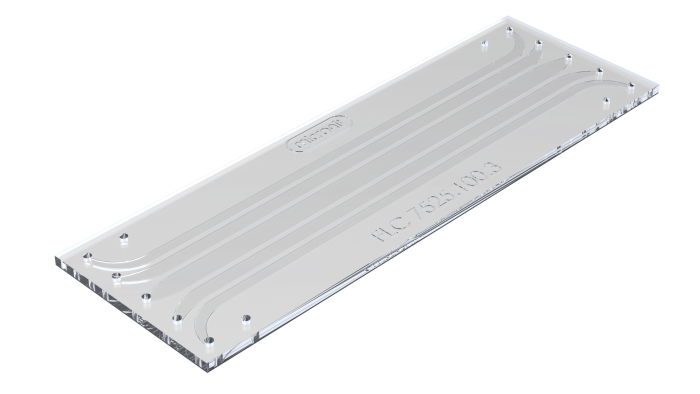shopping_basket
Thin bottom flow cell, 75x25mm
SKU
FLC7525
Availability:
check_circle In stock
As low as $753.11
per pack of 2
Pack of 2, microscope slide format (75x25mm) thin botom flow cells
Application possibilities
A flow cell / observation cell is a sample cell designed so that liquids sample, for instance containing cell’s, proteins or particles, can be continuously flowed though a observation area.
Our glass flow’s cell are intended for situation where the optical properties are extremely critical and are suitable for high resolution imaging. They are often used in combination with fluorescent markers.
As alternative to continuously flowed sample it’s also possible to apply stopped flow observation by adding pressure control on both the cell inlet and outlet.
Research examples can be for instance:
- In-line sampling of liquids, mostly using a optical read out.
- Cell observation / counting
- Measurement of fluorescent response.
- Combined with surface chemistry they are used as base for NGS technology (Next-Generation Sequencing)
Unique selling point
- The channels doesn’t have any substantial roughness and are fully optical transparent due to the etching process used.
- Glass offers sublime optical transparency and low autofluorescence.
- D263-Bio is the material of choice for when fluorescent markers are used, this material featurea a very low autofluorescence also above 600nm.
- The bottom layer thickness (thickness from bottom face up to the channel) is comparable with a #1.5 coverslip
- Optionally available with a hydrophobic or APTES coating.
- The miscroscope slide format (75x25mm) offers compared to a 45x15mm format:
- more channels per chips (5 instead of 3)
- longer observation length (+30mm)
Product configurations
| SKU | Channel 1 width | Channel 2 width | Channel 3 width | Channel 4 width | Channel 5 width | Channel height (all channels) | Coating |
| 11003545 | 1400µm | 1900µm | 2900µm | 1900µm | 1400µm | 50µm | Non, hydrophobic |
| 11003536 | 1500µm | 2000µm | 3000µm | 2000µm | 1500µm | 100µm | Non, hydrophobic |
Interfacing
This product requires an alternative Catalog Product Link for use in combination with our Fluidic connect Pro holder.
To connect all three channels at the same time, you need 10 ferrules. The ferrules are available in sets of five. Make sure you order two sets if you want to connect all channels at the same time.
| Unit of measurement | pack of 2 |
|---|---|
| Interface type | Topconnect |
| Channel location | 175µm from bottom of chips |
| Chip thickness | 1.3mm |
| Chip material | Borosilicate glass - D263 bio |
| Number of inlets | 5 |
| Number of outlets | 5 |
| Icon | Label | Description | Type | Size | Download |
|---|---|---|---|---|---|
 | Drawing FC 7525.100.3 | Technical drawing for 75x25mm flow cell, 100µm deep. | 85.2 KB | Download | |
 | Drawing FC 7525.50.3 | Technical drawing for 75x25mm flow cell, 50µm deep. | 133.7 KB | Download |
Customer Questions
We found other products you might like!
- Holder with insert set for 75x25mm chips$1,912.36


